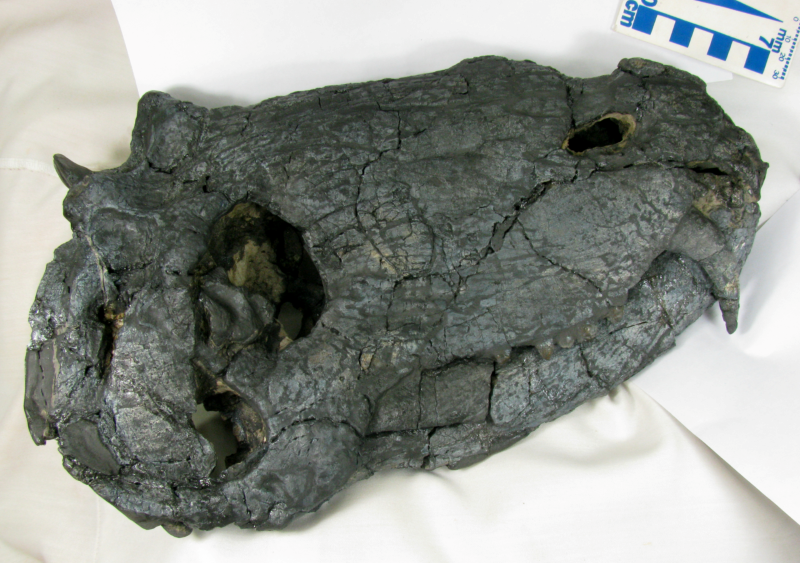
A remarkable fossil has revealed the largest predator of the species Pampaphoneus biccai. This astonishing discovery dates back to a staggering 265 million years and was unearthed in the rural region of São Gabriel, located in Southern Brazil.
Details about the unearthed fossil
The fossil has revealed the world’s largest predator and is a true wonder, boasting a complete skull along with some key skeletal remains, including ribs and arm bones.
Pampaphoneus, a member of the early therapsid group known as dinocephalians, inhabited our planet just before the most catastrophic extinction event in Earth’s history, which wiped out a staggering 86 percent of all animal species across the globe.
Prior to this cataclysmic event, dinocephalians were among the dominant groups of large land-dwelling animals. These creatures came in various sizes and had both meat-eating and plant-eating members.
Dinocephalians were distinguished by their thick skull bones, which is how they got their name, meaning “terrible head” in Greek.
Significance of this discovery
Although well-documented in regions such as South Africa and Russia, these animals are quite rare in other parts of the world. Remarkably, Pampaphoneus biccai stands as the sole known species of its kind in Brazil.
“The fossil was found in middle Permian rocks, in an area where bones are not so common, but always hold pleasant surprises,” explained Mateus A. Costa Santos, the primary researcher behind the study and a graduate student at the Paleontology Laboratory, Federal University of Pampa (UNIPAMPA).
He further said, “Finding a new Pampaphoneus skull after so long was extremely important for increasing our knowledge about the animal, which was previously difficult to differentiate from its Russian relatives.”
The diligent efforts of paleontologists from UNIPAMPA and the Federal University of Rio Grande do Sul (UFRGS) paid off. They invested a full month of strenuous, day-to-day fieldwork to retrieve this valuable fossil.
Delay in the discovery
The impact of the pandemic led to a delay of an extra three years before the fossil could be thoroughly cleaned and studied.
Professor Stephanie E. Pierce, a co-author of the study and a member of the Department of Organismic and Evolutionary Biology, as well as the Curator of Vertebrate Paleontology and Mammalogy at the Museum of Comparative Zoology at Harvard, played a vital role in examining this creature.
She collaborated with the senior author and head of the lab, Professor Felipe Pinheiro of UNIPAMPA, as part of their ongoing research on Brazil’s Permo-Triassic fossil record.
Professor Pierce remarked, “This animal was a gnarly-looking beast, and it must have evoked sheer dread in anything that crossed its path.”
She further said, “Its discovery is key to providing a glimpse into the community structure of terrestrial ecosystems just prior to the biggest mass extinction of all time. [It is a] spectacular find that demonstrates the global importance of Brazil’s fossil record.”
The second Pampaphoneus skull ever found in South America
This newly found specimen marks only the second Pampaphoneus skull ever unearthed in South America. Notably, it surpasses the size of the first discovery and offers an unparalleled insight into its physical characteristics due to the remarkable preservation of its bones.
265-million-year-old fossil belongs to oldest, largest South American predator before dinosaurs
Pampaphoneus biccai is the oldest and largest predator whose fossils were discovered in South America. pic.twitter.com/jWHyQZQGQM— RVIN (@Vinodrviv) September 13, 2023
Professor Felipe Pinheiro elaborated, “Pampaphoneus played the same ecological role as modern big cats.”
He further said, “It was the largest terrestrial predator we know of from the Permian in South America. The animal had large, sharp canine teeth adapted for capturing prey. Its dentition and cranial architecture suggest that its bite was strong enough to chew bones, much like modern-day hyenas.”
A potentially unidentified fossil of Pampaphoneus skull
Despite the already substantial size of the newly discovered Pampaphoneus skull, measuring nearly forty centimeters, research indicates the existence of a previously unidentified fossil that could represent a third individual.
Remarkably, this potential third specimen could be up to twice the size of the recent find. While we only have a fragment of its jaw, the distinctive characteristics present are enough to classify it as belonging to the Pampaphoneus species.
Scientists estimate that the largest Pampaphoneus individuals might have stretched to nearly three meters in length and weighed around four hundred kilograms. These skilled predators had a varied diet, including small to medium-sized animals.
Paleontological potential of Pampa
Interestingly, in the same area where this fossil was discovered, some of the creatures that may have served as their prey have also been identified. These include the small dicynodont Rastodon and the massive amphibian Konzhukovia.
The newfound Pampaphoneus specimen, along with the other creatures uncovered in this region, underscores the rich paleontological potential of the Pampa region for making significant fossil breakthroughs.
See all the latest news from Greece and the world at Greekreporter.com. Contact our newsroom to report an update or send your story, photos and videos. Follow GR on Google News and subscribe here to our daily email!



